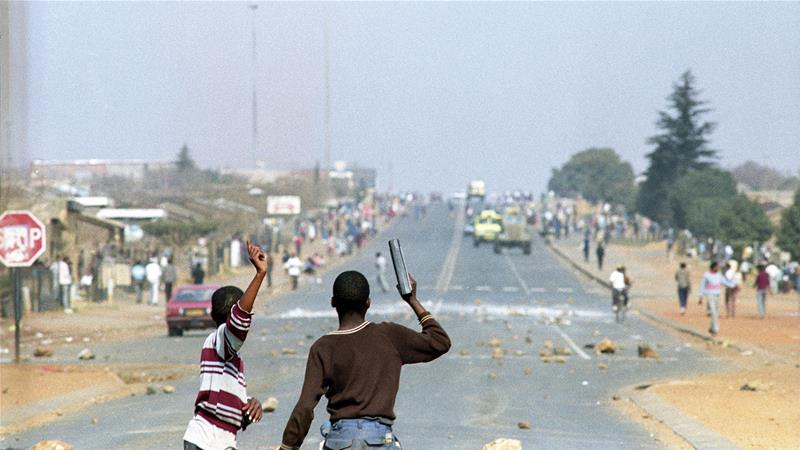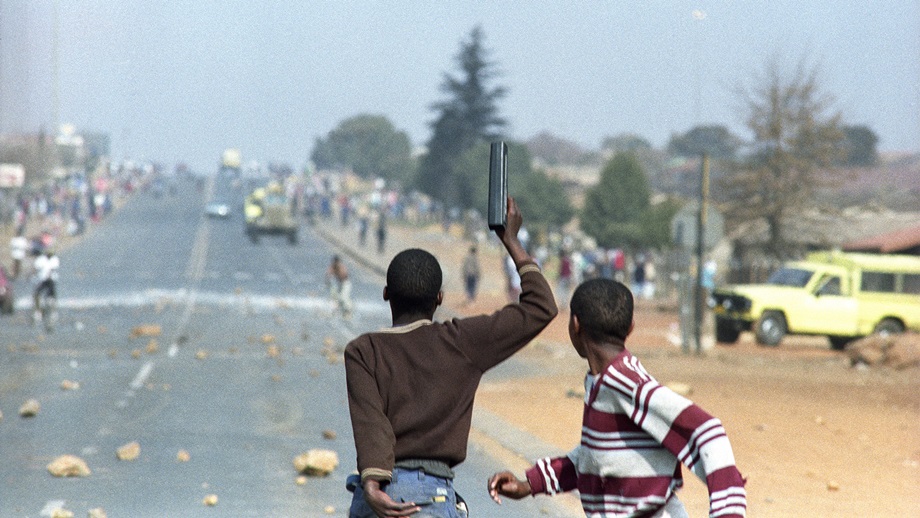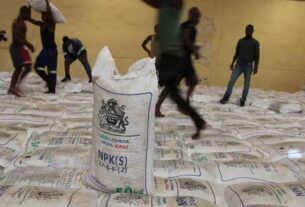Can an image capture the horror of generations of repression and resistance, and is it a photojournalist’s job to try?

Frame 1: A schoolboy points a toy gun at armoured police vehicles in Sebokeng, South Africa, 1991 [Photo courtesy: Greg Marinovich]
Photographs have a life free of context and explanation. And they do not.
When discussing an image, I am often torn between what we can see in the image and that which we cannot. This is especially so when the images have emerged from a place and time that has a complex, perhaps contradictory, history.
This triptych was shot in the sprawling but obscure black township of Sebokeng, south of Johannesburg, as the winter of 1991 was easing its hold on the highveld, but still weeks before the summer rains would settle the haze and dust.
Sebokeng, like many of the areas designated for black people under apartheid, suffered from extraordinary levels of political violence during the early 1990s, especially if they had migrant workers’ hostel complexes. More on that later, but suffice to say that I was familiar with the quickest way to every hostel in and around Johannesburg.
Two boys, a toy gun and a camera
Any of the three images could hold its own to tell one of the most recognisable aspects of the South African story of those times – the youthful defiance of apartheid’s all-powerful enforcers. The tender years of the children is alarmingly familiar, as is the distant might of the approaching security forces.
The pistol held by the taller (possibly older?) of the boys is a toy; not only useless as a weapon, but sure, we feel, to draw the ire, and possibly the fire of the policemen lurching inexorably forward in their armoured behemoths.
The school jersey worn by the boy with the gun prompts memories of my younger self; of a garment that barely helped against the morning chill and then scratched in the midday sun. While we may all have been blighted with uniforms made to an equally low standard, my childhood could not have been more different from those children’s. I grew up as a middle-class white boy in a safe, comfortable neighbourhood; my prosperous future almost guaranteed by my racial designation and constrained only by my imagination or failings.
Even that fine, broad road is not a gift to easy commuting, but a threat. It was part of the architecture of apartheid that would allow the police or military to access and traverse – and thus control – the densely-populated black residential areas should there be “trouble”. That the white planners understood that their social engineering would eventually lead to uprisings is in itself disturbing and dispels any of the “separate but equal” nonsense propagated by the white minority regime.
How does this factor into the taking of the images; the reading of them? While I was committed to a non-racial future and was a “radical” in comparison with every one of the boys I had spent most of my school years with, I could not truly experience what it was like to live every day and night under the heel of oppression and poverty as those two boys in Sebokeng did. I was aware of the broader strokes of history and what was happening that day, that week, in Sebokeng, but I lacked the insider knowledge to read every aspect of what I was seeing, hearing, smelling
A bloody transition, ignored
The transition epoch away from apartheid was loosely defined as being from the release of Nelson Mandela from prison in early 1990 up to his inauguration as president in 1994.
The bloody collateral damage during a supposed negotiated transition from apartheid rule to a non-racial democracy has been tacitly ignored. It does not fit into the inspirational narrative.
Yet the first of those two years saw 49 massacres recorded by the Human Rights Commission (HRC). The HRC defined a massacre as the killing of 10 or more people in a single occurrence.
The bloody collateral damage during a supposed negotiated transition from apartheid rule to a non-racial democracy has been tacitly ignored. It does not fit into the inspirational narrative of the universal moral right overcoming white supremacy.
How can we discuss a seemingly simple photograph that is a signifier of generations of repression and resistance? Can these images, without words, contain the weight of the massacre of 50 residents of Sebokeng as they sat in vigil over a slain African National Congress (ANC) activist earlier that year, or somehow convey the nihilist horror of the Boipatong massacre that would occur nearby, a few months in the future?
A family wiped out
I rarely went into those conflict zones at night, when the spooky illumination from the high mast lights would be augmented only by car headlights or the disconcerting strobing of blue police lights.
On drier nights, the streets were often manned by young men and teenagers who felled trees across thoroughfares and burned tyres to deter would-be killers, or dug knee-deep trenches across backroads to trap the otherwise unstoppable armoured vehicles the police used. While most of the mass killings were committed by supporters of the Inkatha Freedom Party (IFP) with the direct or indirect aid of the white security forces, followers of the ANC were also guilty of such acts.
The end of decades of white rule was messy. While many political parties and groups were participating in talks to form a new South Africa, on the ground, other bloodier strategies were playing out as the security forces of the then still all-white government tried to chip away at the ANC and Mandela’s almost messianic status. There were no good guys, it seemed then, just less bad ones.
The settlements earmarked for black and “coloured” (mixed-race) people suffered many such instances of violence. On one drenched night, that year or the next, my pager alerted me to a Sebokeng family having been wiped out by attackers.
It was with more than the usual trepidation that four of us sprayed and slid through deserted streets on our way to the house. The details of what we found there are too gruesome to describe. Even a child hiding in a closet had been found and killed.
Why was an entire family wiped out? Was it political, gang-related, a family conflict? I never found out. As with so many of the less publicised killings, the news machine – and I – moved on to the next horror.
Would one of the images from that night do a better job than the child with the toy pistol at showing just what the morally-rotten political and social system had provoked?
What is a photojournalist’s purpose?
To answer that, we have to first establish if it is the purpose of a photojournalist or documentarian to share a moment regardless of its effect, or to satisfy a need to create an historical document of injustice, or to feed the vicarious delight of an otherwise unmoved audience?
I feel it is critical to compel an audience to be curious and engaged, be it on the day or in years to come.
The historically-unimportant scene that day in Sebokeng was a distillation of so many things I had seen but which never played out within the frame of a camera viewfinder.
I like the fact that of the only three negatives exposed of that scene, the information available to the viewer grows and even develops a narrative plot with a twist. It allows our imaginations to come into play and provokes us to doubt the completeness, the broader veracity, of a single image and a singular viewpoint.
“The essential cruelty of the situation is not that all blacks are virtuous and all whites villainous, but that whites are conditioned not to see anything wrong in the injustices they impose on their black neighbours.”
Ernst Cole, House of Bondage, 1967.
SOURCE: AL JAZEERA NEWS
The statements, views and opinions expressed in this column are solely those of the author and do not necessarily represent those of Independent Press.



![ONLY FOR What this picture means to me - DON'T USE! [Photo courtesy: Greg Marinovich] ONLY FOR What this picture means to me - DON'T USE!](https://www.aljazeera.com/mritems/Images/2019/12/10/93018a849b8b48d5bcd2a56823a5273b_18.jpg)
![ONLY FOR What this picture means to me - DON'T USE! [Photo courtesy: Greg Marinovich] ONLY FOR What this picture means to me - DON'T USE!](https://www.aljazeera.com/mritems/Images/2019/12/10/6aef122f0c5043bb8c482cf79cb05be4_18.jpg)


